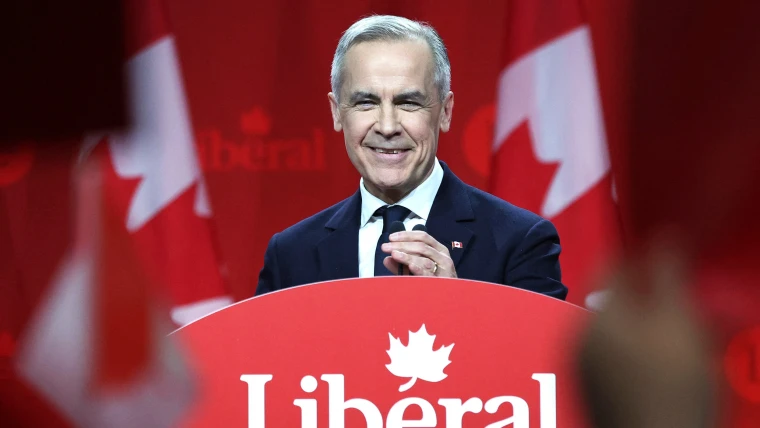
Mark Carney to Replace Justin Trudeau as Canada’s New Prime Minister
In a dramatic political shift, Mark Carney, the internationally acclaimed economist and former central banker, has emerged as the new leader of Canada’s Liberal Party, positioning him to succeed Justin Trudeau as the next Prime Minister of Canada. Carney won the party leadership with a staggering 86% of the vote, signaling a new era in Canadian politics.
Trudeau’s Resignation and Carney’s Path to Power
The end of Justin Trudeau’s tenure came as a surprise to many. After leading Canada for a decade, Trudeau announced his resignation on January 6, 2025. His decision to step down was influenced by a range of pressures, including rising inflation, a housing crisis, and increasing dissatisfaction within his own party. Trudeau’s resignation followed several months of internal conflicts within the Liberal Party, culminating in the abrupt departure of Finance Minister Chrystia Freeland over disagreements on economic strategy.
Trudeau’s approval ratings had reached historic lows, with his party trailing the opposition Conservatives by a significant margin. The final blow came when U.S. President Donald Trump imposed harsh tariffs on Canadian goods, something Trudeau’s administration struggled to manage. In his farewell speech, Trudeau admitted that it was time for a fresh face to lead the country, stating, “Canada deserves a clear choice, and I can’t give my all if I’m battling my own party.”
Mark Carney: From Small Town to Global Stage
Mark Carney was born on March 16, 1965, in Fort Smith, Northwest Territories, and grew up in a modest family environment. His father, Robert James Martin Carney, was a high school principal, and his mother, Verlie Margaret Kemper, was a homemaker who later became a teacher. Carney’s early life in the remote northern part of Canada shaped his outlook and drive, leading to a stellar academic career.
After excelling in high school, Carney earned a scholarship to Harvard University, where he studied economics. He graduated with honors in 1988 before moving on to the University of Oxford, where he earned both a Master’s and a Doctorate in economics. During his time at Oxford, Carney also developed a personal connection with Diana Fox, an economist who would later become his wife.
A Distinguished Career in Global Finance
Carney’s career trajectory is a testament to his exceptional skills and ambition. He started his professional journey in 1990 as a member of Goldman Sachs, working in various international offices, including London, New York, Tokyo, and Toronto. Over the years, he became known as a rising star in global finance, tackling complex projects such as facilitating South Africa’s entry into international bond markets and handling the financial crises in Russia.
In 2003, Carney made the leap to public service, becoming Deputy Governor of the Bank of Canada. By 2008, he was appointed Governor of the Bank of Canada, a role in which he gained international acclaim for his handling of the 2008 financial crisis. Carney’s leadership helped Canada avoid the worst of the global recession, earning him praise worldwide.
In 2013, Carney became the first non-British Governor of the Bank of England, where he successfully guided the UK economy through the turbulence of Brexit. After leaving the Bank of England in 2020, he continued to influence global financial policy, working with Brookfield Asset Management and serving as the UN Special Envoy for Climate Action and Finance.
Carney’s Entry into Politics: A Reluctant Leader
Despite his extensive background in finance, Carney had long been seen as a reluctant political figure. While there was speculation in 2012 that he might enter politics, he consistently denied any ambitions to do so, focusing on his role as Governor of the Bank of England. However, over time, his connection to the Liberal Party deepened, particularly through his advisory role in the COVID-19 economic recovery plan.
By 2024, Carney’s growing involvement in Canadian politics became evident when he chaired the Liberal Party’s Task Force on Economic Growth. This set the stage for his official leadership bid, which he launched in January 2025. His entry into the race was marked by his calls for fresh ideas and a more pragmatic approach to Canada’s challenges. His overwhelming victory in the Liberal Party leadership race on March 9, 2025, made him the party’s official leader and the designated successor to Trudeau.
Personal Life: A Family Man with Global Influence
Carney’s personal life offers a glimpse into the man behind the political figure. He met his wife, Diana Fox, at Oxford, and together they have raised four daughters. Diana, an economist with a focus on climate and finance policy, shares her husband’s dedication to progressive causes, including sustainability and climate action. The couple’s family life is centered around a strong sense of values, with Mark known for his active participation in family activities like jogging and fishing trips with his daughters.
Despite their high-profile careers, the Carneys have managed to maintain a sense of groundedness, often returning to Edmonton to reconnect with their roots. Diana has also been an advocate for income inequality, adding another layer of social consciousness to their public image.
Carney’s Vision: Economic Pragmatism Meets Green Ambition
Carney’s political platform is a blend of economic pragmatism and bold environmental policies. One of his first major challenges as Prime Minister will be navigating the escalating tariff war with the United States, with President Trump’s 25% tariffs on Canadian goods threatening to severely impact the Canadian economy. Carney has vowed to respond with “dollar-for-dollar” retaliatory tariffs, targeting U.S. energy and agriculture sectors.
On the climate front, Carney has pledged to overhaul Canada’s approach to carbon taxation. He has criticized Trudeau’s consumer carbon tax and instead introduced a “green incentive program” that offers tax breaks for eco-friendly choices such as electric vehicles and home retrofits. This program will be funded by cuts to fossil fuel subsidies, aiming to stimulate green investments while reducing emissions.
Economically, Carney aims to tackle the country’s housing crisis, boost productivity, and improve the healthcare system. He has promised to focus on economic growth and job creation, while taking a more targeted approach to immigration policy, ensuring that immigration levels align with Canada’s housing and healthcare capacities.
A Divided Nation: Support and Criticism
Carney’s rise to power has sparked a range of reactions across Canada. Supporters hail him as a pragmatic leader who can navigate the nation through its economic and environmental challenges, while critics are concerned about his ambitious green policies and his lack of direct political experience.
In particular, Alberta’s oil and gas industry has expressed skepticism about Carney’s environmental stance, which they view as a potential threat to the province’s economy. Meanwhile, Conservative leader Pierre Poilievre has criticized Carney’s approach, claiming that his policies would lead to economic stagnation.
Carney’s views on immigration—particularly his stance on adjusting immigration levels based on infrastructure and labor market needs—are seen as a response to growing public concern about the pressures of high immigration levels on housing and services.
Looking Ahead: Can Carney Deliver?
Mark Carney’s leadership is poised to reshape Canada’s political landscape. His success or failure will depend on his ability to navigate the complex issues facing the nation, from trade wars and housing shortages to climate change and healthcare reform. Carney’s first 100 days in office will be critical, as he seeks to balance ambitious policies with the need for unity in an increasingly polarized country.
For a consultation about Immigration options, reach out to the CAD IMMIGRATION today!





